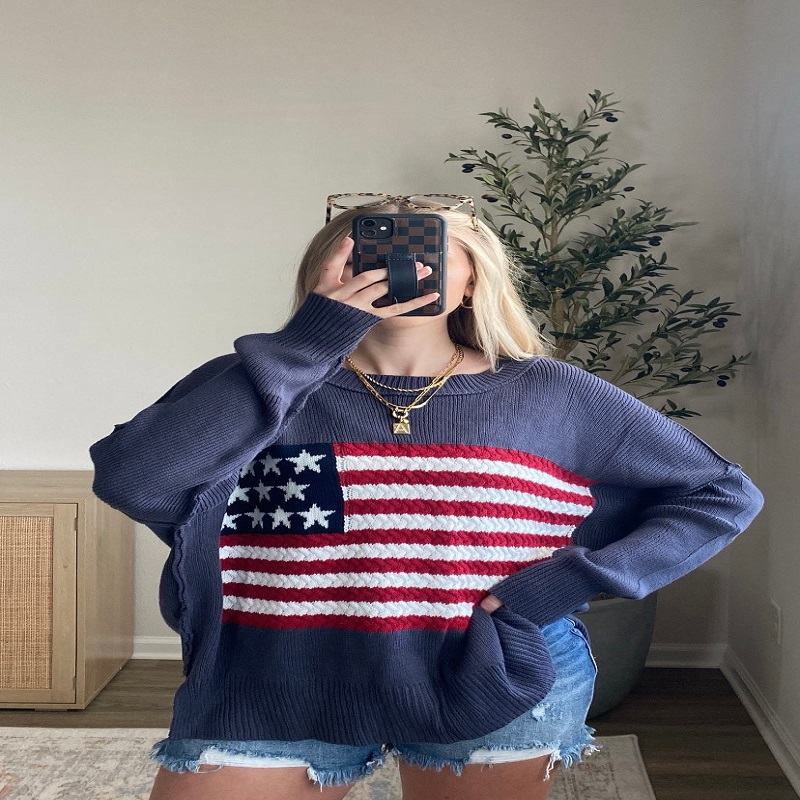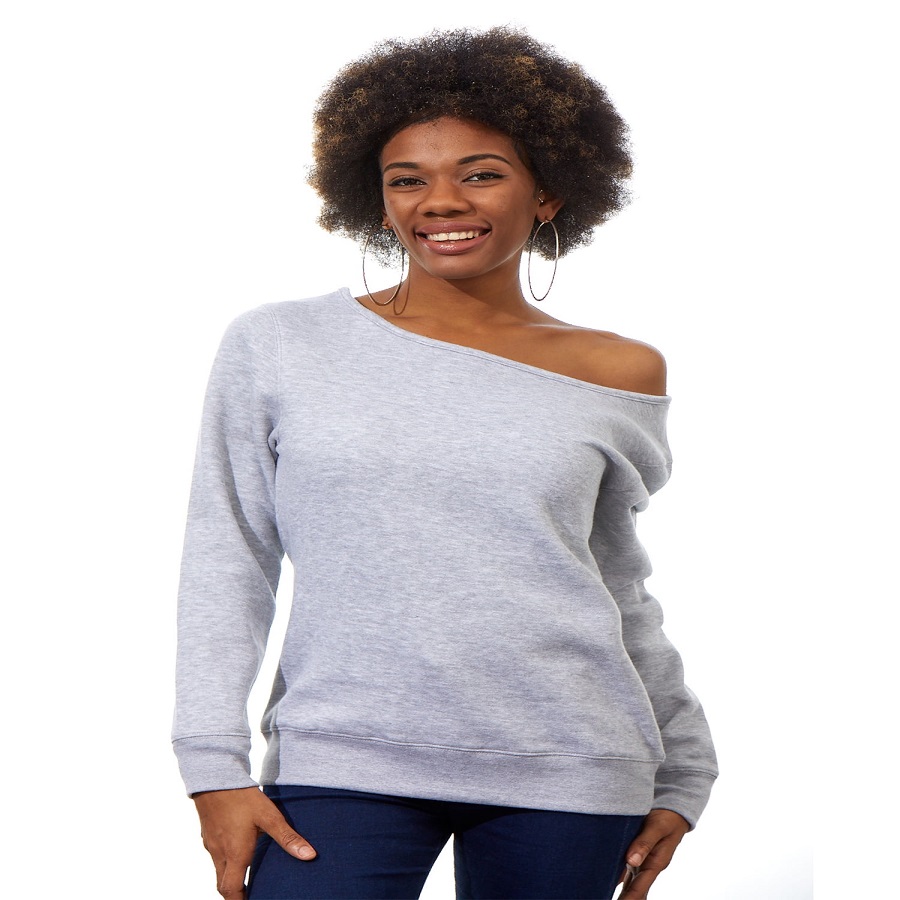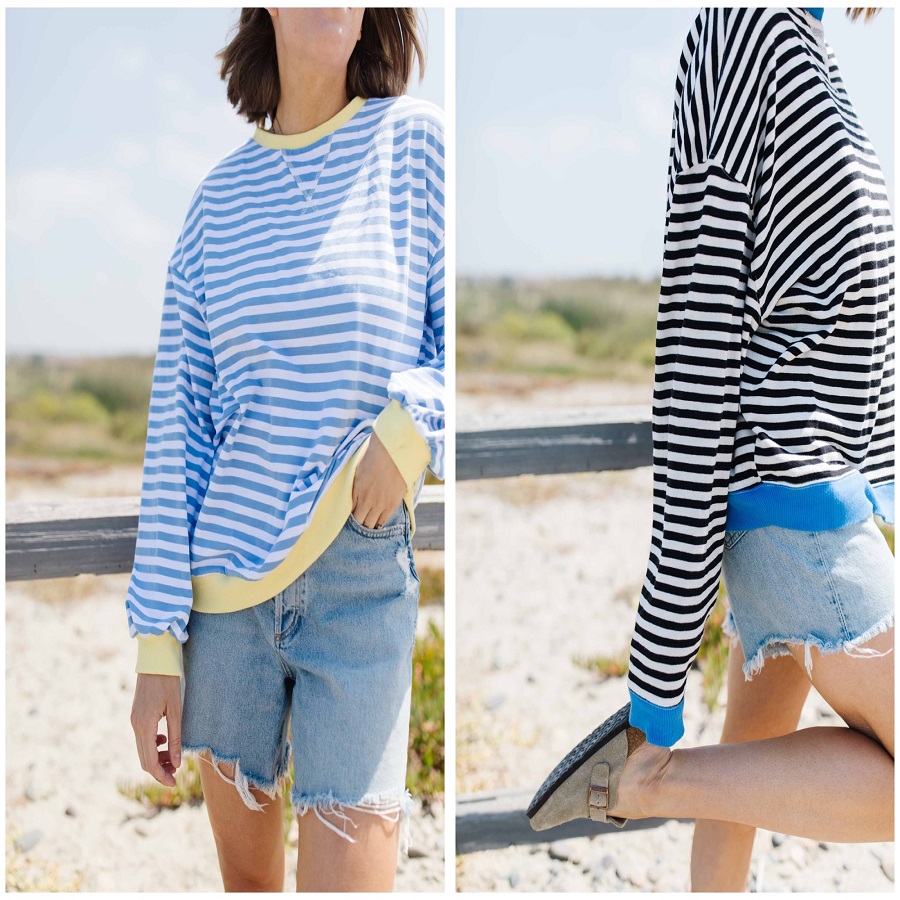Introduction to Sweater and Sweatshirt Styles
When you think of comfort and warmth in clothing, sweaters and sweatshirts likely come to mind. Although the terms are often used interchangeably, there are distinguishable differences between a sweater and a sweatshirt that go beyond their appearance. This section introduces you to a variety of styles that each has to offer.
Sweaters are a knitted garment that typically covers the upper body. They come in various patterns, weaves, and thicknesses. Designs range from crewnecks, V-necks, turtlenecks, to cardigans and pullovers. Each style offers a unique look and level of formality, which allows sweaters to be versatile in fashion.
Sweatshirts, on the other hand, are a soft, comfortable garment usually made from cotton or a cotton blend. Key styles include basic crewnecks, hooded sweatshirts (also known as hoodies), and zip-ups. The fit of sweatshirts can vary from tight to loose, but they all maintain a relaxed and casual feel. Unlike sweaters, sweatshirt designs tend to be simpler, often solid in color or featuring a graphic print.
Both sweaters and sweatshirts have evolved over time to include a variety of embellishments and features. Examples include elbow patches, decorative buttons, or printed logos and statements, each adding character to the basic style.
When debating ‘sweater vs sweatshirt,’ consider the style factor. Sweaters can easily be dressed up for a business lunch, while sweatshirts are synonymous with a laid-back weekend outfit. However, some sweatshirts are designed to bridge the gap between casual and smart-casual, making them suitable for a range of occasions. In the evolving world of fashion, the lines between sweater and sweatshirt styles continue to blur, as designers incorporate elements of both into their creations.
 The Historical Context of Sweaters and Sweatshirts
The Historical Context of Sweaters and Sweatshirts
The journey of sweaters and sweatshirts through time reveals much about their origins and cultural significance. Sweaters date back to the 15th century, originating from the Channel Islands. Fishermen and sailors wore them to fend off the severe cold out at sea. These early sweaters, known as ‘Guernseys’, were tightly knit to repel water and provide warmth. Over centuries, sweaters have woven their way into fashion, adapting to traditions and trends. Today, they symbolize both heritage and high fashion.
Sweatshirts began their story later, arising in the early 20th century. Their creation is attributed to Benjamin Russell, a sportswear manufacturer who aimed to find a warmer, more comfortable alternative to itchy woolen football jerseys. The first sweatshirts were a blend of cotton and were embraced by athletes for their ability to absorb sweat and provide ease of movement. They later transcended the sports world, becoming a staple in American casual wear post World War II. Sweatshirts have since gained worldwide acceptance, often linked to youth culture and leisurewear.
As we ponder on ‘sweater vs sweatshirt’, we must acknowledge the rich histories behind these garments. This historical relevance adds an extra layer of character when choosing between them for fashion or function. Whether it’s the traditional, artisanal aura of sweaters or the functional, relaxed vibe of sweatshirts, both have secured their place in the tapestry of clothing history.
Key Materials and Fabric Types
Exploring the materials and fabric types is crucial when comparing a sweater and a sweatshirt. The choice of material can significantly affect comfort, durability, and occasion suitability. Let’s delve into the common fabrics used for each garment.
Sweaters often feature natural fibers like wool, cashmere, or cotton. Wool sweaters are warm and cozy, perfect for chilly weather. Cashmere provides a luxurious feel and extra warmth without adding bulk. Cotton sweaters strike a balance between comfort and breathability, suitable for less cold conditions. Some sweaters blend synthetic materials like polyester for added stretch and durability.
Sweatshirts usually consist of thicker, heavier fabrics, primarily cotton or cotton blends. The inside may have a fluffy ‘fleece’ layer to trap heat and ensure softness against the skin. Polyester is also a common addition, contributing to the sweatshirt’s shape retention and washability. Advanced sweatshirts may include performance-based materials like ‘tech fleece’ that offer moisture-wicking properties catering to active lifestyles.
In summary, sweaters can range from fine knits of natural yarns to robust, synthetic blends. Sweatshirts stick to heartier, often cotton-based materials that prioritize comfort and warmth. When weighing ‘sweater vs sweatshirt’, consider these material aspects to guide your choice.
Design and Structural Variations
When evaluating sweater vs sweatshirt, it’s essential to consider design and structural variations between the two. Though both can serve as cozy layers, their construction sets them apart. Sweaters generally possess a knitted texture, allowing for a range of intricate patterns. Such versatility extends to include cable knits, ribbed designs, and jacquard weaves, each introducing a different aesthetic and thickness.
Sweatshirts, in contrast, are typically crafted with a smooth external surface, often complemented by a soft, brushed interior for added comfort. Their design simplicity is their strength, offering a clean, versatile canvas for bold graphics or statements. The more traditional sweatshirts may only have a ribbed waistband and cuffs, while modern iterations could feature high-low hems, side zips, or oversized silhouettes.
The construction of sweaters can include various collar styles, from the casual crewneck to the formal shawl collar. Layering options such as cardigans or button-down versions provide added flexibility in styling. Sweatshirts generally have fewer collar variations, but the addition of a hood or a front zipper can transform the garment, increasing its practicality.
The structural difference extends to fit as well; sweaters can be tailored for a snug fit, contouring the body’s shape, or designed with a loose, casual drape. Sweatshirts lean towards a more relaxed fit, often cut with roomier proportions to ensure ease of movement and a laid-back appearance.
In pondering sweater vs sweatshirt, recognize the nuanced design and structural differences. Sweaters exhibit technical knit patterns and favor a variety of fits, while sweatshirts maintain a straightforward design with a focus on comfort and casual style.
From Casual to Formal: Occasions for Each
When considering sweater vs sweatshirt for different occasions, choice becomes a reflection of personal style and the event’s formality. Sweaters, with their diverse styles, step up as the more formal counterpart. They fit seamlessly into business-casual settings or dinners at upscale restaurants. A fine-knit V-neck sweater can complement a collared shirt and tie, embodying sophistication. Turtlenecks lend themselves to artistic environments, pairing well with blazers for a polished yet creative look.
Sweatshirts, by nature, are less formal and champion comfort and ease. They’re your go-to for gym sessions, casual meet-ups, or cozy evenings at home. However, the rise of athleisure has seen sweatshirts in smarter contexts, like casual Fridays at the office or a coffee date. High-quality, plain sweatshirts can occasionally replace a sweater for a laid-back, yet tidy attire.
For transitional occasions, ones that blur the casual-formal line, consider the hybrid versions of these garments. A sweater with a bold graphic may suit a casual party, while a sweatshirt with minimal design and fine tailoring could pass in a smart-casual ensemble. Remember, the final touch comes with your choice of accessories, footwear, and outerwear, which can shift the tone of your sweater or sweatshirt towards the intended dress code.
Care and Maintenance Tips
Correct care can keep both sweaters and sweatshirts looking great over time. Here are some tips:
- Read Labels: Always check the care label for proper washing instructions.
- Washing Sweaters: Use cold water for wool and cashmere; wash cotton in warm water. Turn sweaters inside out to protect fibers.
- Drying Sweaters: Lay flat to dry, shaping to prevent stretching. Avoid hanging which can deform the shape.
- Washing Sweatshirts: Cold or warm wash is fine, but separate colors to prevent bleeding.
- Drying Sweatshirts: Tumble dry on low heat or hang dry. Don’t use high heat, it can shrink the fabric.
- Ironing: Iron on low for cotton sweaters. Avoid ironing graphic prints on sweatshirts. Use a pressing cloth for protection.
- Storage: Fold sweaters to maintain shape, don’t hang. Sweatshirts can be hung or folded.
- Moth Prevention: For wool sweaters, use cedar blocks or mothballs in storage.
By following these care tips, your sweaters and sweatshirts will stay in prime condition for years. Remember that proper maintenance can also conserve the vibrancy of colors and the integrity of the material whether it’s a fine knit or a cozy fleece.
Popular Brands and Trends
When exploring sweater vs sweatshirt styles, popular brands play a pivotal role. They set trends that influence our choices. For sweaters, brands like Ralph Lauren and Banana Republic lead with classic and preppy styles. They offer a range of knits that blend tradition with modern fashion. Luxury brands such as Burberry and Armani add a high-end twist to the classic sweater, infusing it with designer appeal.
In the realm of sweatshirts, brands like Nike and Adidas are synonymous with sporty, casual wear. They constantly introduce new technologies like moisture-wicking fabrics and innovative fits. Streetwear labels like Supreme and Off-White have elevated the sweatshirt to a fashion statement with their unique designs and limited-edition releases.
Trendwise, the resurgence of vintage styles is evident in both sweaters and sweatshirts. Retro patterns and logos are making a comeback, appealing to a sense of nostalgia. Eco-friendly and sustainable options are also gaining traction as consumers become more environmentally conscious. Brands that offer organic or recycled materials are quickly rising in popularity.
Moreover, the crossover between casual comfort and workplace attire has given rise to ‘smart comfort’. This trend merges the relaxed fit of sweatshirts with finer materials, suitable for more formal settings.
To keep up with trends while selecting a sweater or sweatshirt, pay attention to seasonal fashion shows, social media influencers, and industry insiders. They can help guide you to the latest styles and what might be the next big thing in knitwear or leisurewear. But, in the end, the right choice should align with your personal style and lifestyle needs.
Making the Right Choice for Your Wardrobe
Choosing between a sweater and a sweatshirt depends on your personal needs and style. For a polished, formal look, sweaters are the top choice. Their variety in material and design fits dressier occasions. Cashmere sweaters add luxury; wool sweaters bring warmth. A cotton sweater works well for a smart yet comfortable outfit.
If you crave comfort or a laid-back style, a sweatshirt is ideal. It’s perfect for running errands, gym sessions, or relaxing at home. High-quality sweatshirts can even edge into smart-casual settings. Look for simple designs and good tailoring to elevate your casual look.
Remember, your wardrobe should reflect who you are. Both sweaters and sweatshirts have their place in a balanced wardrobe. It’s not just about choosing one over the other. Instead, it’s about having the right option for the right moment. A classic sweater can impress at a job interview. A trendy sweatshirt can show your style at a casual hangout.
Consider your lifestyle, the climate you live in, and how these garments blend with your existing clothes. Mix and match to find the perfect balance for your unique style. Whether you choose a sweater, a sweatshirt, or both, make sure they fit well and make you feel confident. And, don’t forget to care for them properly to ensure they last.

